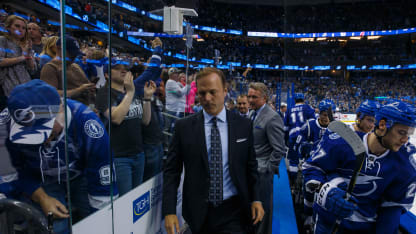In the end, 94 points weren't enough. At least not this season. The Lightning finished the regular season one point behind the Boston Bruins and Toronto Maple Leafs for the final playoff spot in the Eastern Conference. The point total wasn't high enough, but ultimately, the Lightning didn't play well enough.
And that's the biggest takeaway from the 2016-17 season.
Mishkin: The 2016-17 season - a three-part story
In the end, 94 points weren't enough for the Lightning to break through, writes broadcaster Dave Mishkin

© Scott Audette/Getty Images
By
Dave Mishkin
TampaBayLightning.com
The post-season comments from players, coach Jon Cooper, GM Steve Yzerman and even owner Jeff Vinik were consistent - missing the playoffs is unacceptable. The high standard the Lightning have set in the past few years is one that wasn't met this year. It won't be lowered. Instead, they will strive to reach it next season.
How did this happen? The reasons have been well-documented. Prior to the last two months of the regular season, the team's play was sub-par. They allowed too many scoring chances and goals. Versus the three bottom teams in the NHL - Colorado, Vancouver and Arizona - the Lightning went just 1-5-0. They dealt with significant injuries to key players. All of this is true.
It's also true that over the course of an 82-game regular season, there are key segments and even individual games that can swing a team's fortunes in different directions. I felt the Lightning's season had three distinct, separate parts. Today, I'm going to take an in-depth look those three chapters - and how, to varying degrees, they intersected with some of those aforementioned problem areas.
Before getting into specifics, a reminder about what teams need to do and what they must avoid if they hope to qualify for the postseason. Once in the playoffs, it's all about wins. Each series is a race to four wins - no matter how, no matter how long. The regular season, however, isn't really about wins. It's about points. The Lightning actually posted two more wins than Toronto this year, but registered one fewer point. So the biggest key for teams during the regular season is to, as much as possible, avoid regulation losses. And especially stay away from regulation losing streaks. Nothing will drop a team down the standings faster than regulation losses.
During their magical 2014-15 regular season, the Lightning didn't lose more than two games in a row at any point - and that includes overtime/shootout losses. Jon Cooper calls it "munching points" - that's when a team is consistently banking points, even if some of those points come in overtime or shootout losses. Of course, if a team does sustain some significant losing streaks, they may need to offset those segments with winning streaks. One of the big reasons why the Lightning rallied to make the playoffs in 2015-16 was that they had two separate winning streaks of seven and nine games. Three-on-three overtime and the shootout are usually toss-ups, but a team can tip the scales with a terrific record in those games. Lastly, a team must try get above the playoff cut line - and stay there. As the Lightning saw first-hand this year, teams that are holding onto playoff spots tend to protect them like a dog with a bone.
Chapter One - Games 1-21. Even Amidst Troubling Signs, A Good Start In The Standings.
There were reasons for concern in Lightning land right off the bat. The Bolts began the regular season with four consecutive home games. They fell behind, 2-0, in three of the four games, and allowed the opening goal in all four. They did rally to win three of them, but poor starts plagued the Lightning for most of the year. The Lightning yielded the game's first goal in 49 of their 82 games.
Team defense, an area of strength in recent years for the Lightning, was looser. In just two of their first nine games did the Lightning hold the opposition to two or fewer goals. For the season, the Lightning ended up 16th in goals allowed per game, dropping 11 spots from the year before.
During these first 21 games, there was one bad blowout loss - a 6-1 defeat at Madison Square Garden to the Rangers on October 30th - a game in which the Lightning yielded numerous scoring chances. But all teams have clunkers once in a while. A bigger concern was the team's play in some of their closer defeats. In a handful of games, the Lightning didn't attack the opposition's net with enough urgency. There weren't enough screens, tips and second chance opportunities. This was a theme in the following losses: 4-0 to Colorado on October 20, 3-1 at New Jersey on October 29, 3-1 at Florida on November 7 and 3-1 at Nashville on November 21.
But the team also had some strong performances during this segment. Their 4-1 win at Ottawa on October 22 turned out to be one of their most complete games of the year. They dominated the New York Islanders in three separate games, outscoring the Isles, 14-2, and sweeping the season series. Their 4-1 win in Buffalo on November 17 (their first full game after the Steven Stamkos knee injury) was another excellent outing. And even though it was one they lost, the Lightning played quite well in Montreal on October 27.
In their final game before Thanksgiving, the Lightning rallied for a 4-2 victory at home over Philadelphia. That triumph gave them a record of 13-7-1 after 21 games. So in spite of the aforementioned inconsistencies, the Lightning, standings-wise, were in good shape after the first quarter of the season.
Chapter Two - Games 22-52: Problems On The Ice And In The Standings.
In past years, the Lightning had been able to overcome injuries to key players. So when Stamkos sustained his knee injury on November 15 and was going to miss at least four months, the Lightning felt that their past experiences playing without their captain would help them survive. And for a week after the injury, the Lightning played pretty well without Stamkos. Including the game in which he was hurt, the Lightning went 4-1-0 in the five games following the injury. But the wheels were about to come off.
The Columbus Blue Jackets had a terrific season this year and were one of the league's top teams. When they arrived at Amalie Arena on November 29, they were just hitting their stride. Already in the season, they had blown out Montreal, 10-0, and blasted St. Louis, 8-4. A 16-game winning streak was going to be starting the following week. On this night against the Lightning, the Blue Jackets served notice that they were for real. In the process, they completely dominated the home team. The 5-3 final does not do justice to how lopsided it was.
The Lightning followed up that loss with an uninspired defeat in Boston, another game in which they didn't attack the opposition net with urgency. Then came a rematch with Columbus, a game that began the Blue Jackets' long winning streak. It was a similar game to the one the previous week at Amalie Arena. Columbus controlled the first half of the game and built a big lead, then cruised to a comfortable 5-1 victory.
The foundation cracks that had been noticeable early in the year were still there. And the Blue Jackets exposed them. The Lightning weren't playing as a tight, cohesive unit. Nor were they playing with an edge. And they were missing the leadership, both on and off the ice, of Stamkos and Ryan Callahan, who was a late scratch for the game in Columbus. Callahan would appear in only three more games all season.
Heading into their game in St. Louis on December 1, the Lightning had dropped three straight in regulation. And they responded with a strong performance against the Blues. In five-on-five action, the Bolts outplayed the Blues. They were a hungry team that attacked the net. But they weren't rewarded with a win. Or even a point. Instead, St. Louis decisively won the special teams battle, popping in three power play goals en route to a 5-4 regulation win. Games like this one can happen to every team. One area of the game cost the Lightning and offset the good work they did in other areas. But those are the sorts of outcomes a team cannot afford to swallow when they've already lost three in a row.
Back home on December 4 against Washington, the Lightning delivered another strong performance. And this time they were rewarded, picking up a 2-1 shootout win. An overtime loss in Carolina in the second half of a back-to-back earned them a point - and a three out of four during the weekend.
The Lightning had three full days to get ready for their next game, a home contest against Vancouver. It was one the Lightning needed, a contest against a Western team near the bottom of the standings. Instead, it was one of the Lightning's worst outings of the year. Porous defensive play resulted in five goals against and a lopsided loss. Two nights later against the defending Stanley Cup Champion Penguins, the Lightning's penalty kill hurt them again. They gave up three successive power play goals and surrendered a 3-1 lead in another regulation loss. That defeat dropped the Lightning's record to 1-6-1 since Thanksgiving.
The Bolts went to Western Canada in hopes of a turnaround. The trip started well, with a commanding 6-3 victory over Calgary. But they didn't build on it. Another damaging loss to the Canucks came next - a game in which the Lightning dominated play early, but gave up the lead during a poor second period. They had a strong finish to the trip, outplaying Edmonton in the second half of regulation. But they lost the game in a shooutout, surrendering another potential point.
Beginning with their game against Detroit on December 20, the Lightning were playing seven of the next eight at home. Unfortunately, Ben Bishop was injured in the first period against the Red Wings. Andrei Vasilevskiy would finish that game - and then start the next nine in a row.
The segment began nicely. Building on their solid play in Calgary and Edmonton, the Lightning beat both Detroit and St. Louis. They lost in Washington on December 23 in what was a tough scheduling quirk - a back-to-back against a rested opponent. But they followed up with a come-from-behind overtime win over Montreal, an OT loss to Toronto and a New Year's Eve victory over Carolina. That 4-1-1 stretch was reason for optimism. But, as was the case after Thanksgiving, the wheels came off again. The four games immediately after New Year's were all regulation losses. The Bolts gave up 22 goals in those four games.
Many people will point to February 4 as the date when the Lightning's play improved (and that's the beginning of Chapter Three). But I think the Lightning began that process on January 12. Regrouping from the four previous losses, the Lightning tightened up their team defense. Over the next eight games, the final six of which were on the road, the Lightning only had one poor showing. That, unfortunately, came in Arizona, another game the Lightning lost to a team with a poor record. Outside of that one game, though, the Lightning held the opposition to two goals or less in the other seven (not including anempty-netter). The problem in this segment was that the Lightning's strong play didn't result in as many points as they likely deserved - or needed. They lost two games in overtime and a close regulation decision in San Jose. Those eight games took us to the All-Star Break - and the Lightning were feeling pretty good about their game, even though their standings position wasn't ideal. Those good feelings were dashed, however, when they dropped back-to-back regulation decisions at home to Boston and Ottawa coming out of the All-Star Break. They didn't play particularly well in either game and the losses dropped them, heading into their contest against Anaheim on February 4, into last place in the Eastern Conference.
Chapter Three - Games 53-82: A Furious Push.
Through their first 52 games, the Lightning were 22-24-6. In their final 30, they went 20-6-4. Their rise from last place in the Conference to within a point of the playoffs was thrilling, inspiring - and improbable. The Lightning not only traded away Bishop, Brian Boyle and Valtteri Filppula at the March 1 deadline, they lost a handful of more players to injuries in the final two months of the regular season. NHL pundits were left scratching their heads as to how the Lightning were staying in the race. How did they do it - and keep their playoff hopes alive until the final weekend of the regular season?
Jake Dotchin made his NHL debut in that ill-fated loss at Arizona on January 21. He played 11:47. It was his lowest time-on-ice total of the season. Before long, Dotchin was playing alongside Victor Hedman and the duo formed a solid pair. Dotchin's impact allowed Associate Coach Rick Bowness to move Anton Stralman onto a pair with Jason Garrison. Those two pairs, with Braydon Coburn and Andrei Sustr making up the third pair, solidified the Lightning's back end. Scoring chances against diminished - and so did the Lightning's goals against number. The Bolts held the opposition to two or fewer goals in 18 of those final 30 games. They failed to do so in all six of their regulation losses. So, in the other 24 games, in which they posted a 20-0-4 record, they kept the opponent to two or less in 18.
During the 14 games that he played in March, Nikita Kucherov posted 22 points. He netted 10 of his 17 power play goals in the final 23 games of the season. Ondrej Palat had points in 13 of the final 17 games. Brayden Point, who became the number one center after injuries sidelined three other centermen on March 9, posted 15 goals in his final 32 games. Victor Hedman was also a point machine down the stretch and finished second among NHL defensemen with 72 points. Jonathan Drouin provided key plays at crucial times, both in terms of scoring goals and setting up teammates. So the top players on the Lightning did a lot of heavy lifting offensively.
But so did the players who started the season in Syracuse. Yanni Gourde netted his first six NHL goals, including the OT winner against Chicago on March 27. Gabriel Dumont became a fixture in the faceoff circle, particularly in the defensive zone. Luke Witkowski, who was up with the Lightning for most of the year, filled in wherever he was needed. He played right wing and defense. Adam Erne got his first extended look in the NHL and provided the Bolts with important minutes. He also had a two-goal game against Dallas on April 2.
The goaltending was superb in those final 30 games. Prior to the deadline, both Bishop and Vasilevskiy were on top of their game. Then, Peter Budaj, who arrived in the Bishop trade, gave the Lightning quality starts. The three goalies were a big reason why the team lowered its goals against average down the stretch.
The Lightning had seven back-to-backs during those final 30 games. They won all seven of the second games. They also went 9-2-2 in their last 13 road games.
And lastly, the Lightning were a team that was hard to face. They played a physical, urgent game, one that gave the opposition problems.
Alas, not all was perfect, though. It's hard to maintain such a torrid pace indefinitely. The Lightning hit a speed bump in mid-March, losing three consecutive games in regulation. The fans point to the Toronto loss as costly (it was), but the Lightning were coming off a tough trip (they got back home at 5 a.m. the day before the Toronto game) and the Leafs had just suffered a blowout loss to the Panthers. High marks to the Leafs for their performance in that game, but circumstances were working against the Bolts in that 5-0 loss. Circumstances weren't an issue in their loss to Arizona on March 21st,, though. That was the one that stings. Similar to the game at Arizona on January 21, the Lightning defended poorly and, as a result, got burned.
But that one isolated game doesn't - and shouldn't - take away from the team's late-season push.
So, in coming full circle, we are back where we started. The beginning of the season was subpar - and the spirited finish wasn't quite strong enough. At least the fans were treated to an exciting final two months and hopefully, what we saw down the stretch is what we'll see from Game One on next season.


















